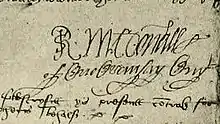Sir James MacDonald | |
|---|---|
| Died | 1626 |
| Resting place | St. Martins Church, London |
| Other names | Sir James MacDonald, Knight of Knockrinsay |
| Title | 9th Clan Chief |
| Predecessor | Angus MacDonald, 8th of Dunnyveg |

Sir James MacDonald, 9th of Dunnyveg (Scottish Gaelic: Séamus Mac Dòmhnuill) (died 1626), was the last chief of Clan MacDonald of Dunnyveg or Clan Donald South. He was most often known as James M'Connall from the Gaelic pronunciation of the name Mac Dhòmhnaill, the modern Macdonald spelling being the anglicization of the name.
Biography
He was a son of Angus MacDonald, 8th of Dunnyveg. He was a hostage and imprisoned a number of times in his lifetime. He was knighted Sir James of Knockrinsay. At the Battle of Traigh Ghruinneart on the Isle of Islay in 1598, he led forces against Sir Lachlan Mor MacLean, 14th Chief of Duart. James was wounded in battle but his forces killed MacLean.[1]
He then fought Hector Og Maclean, 15th Chief who sought revenge for the death of his father in the Battle of Benbigrie.[2][3]
Following the Battle of Benbigrie, James fled to Ireland; returning to Scotland, he was captured by the Earl of Argyll and subsequently imprisoned in Edinburgh Castle from 1604 to 1615.[4] In the spring of 1615, James escaped captivity and led a force to recapture Dunyveg Castle from Sir John Campbell of Cawdor in June, holding it until the castle was recaptured by a force under the Earl of Argyll in October.[5] Following James's defeat at Islay, he fled to Spain and, after returning from exile, was given a pension from King James VI of Scotland and lived in London, never visiting Scotland again and died in London in 1626. He was buried in St. Martins Church, London.
Family
He married Margaret, daughter of Sir John Campbell of Cawdor, without issue. He supposedly fathered a son Donald Gorm, to an unknown woman. (need citation)
References
- ↑ Angus Macdonald; Archibald Macdonald (1900). The Clan Donald, Volume 2.
A fierce battle was fought at a place called Traigh Ghruinneart, at the head of Loch Gruinneart. The Macdonald leader is said to have displayed some strategy at the beginning of the day. ... Nor did the Clan Donald get off scatheless. About 30 of them were slain and 60 wounded, while Sir James, who was dangerously wounded by an arrow through the body, was during most of the following night left for dead among the slain.
- ↑ John Patterson MacLean (1889). A History of the Clan MacLean from Its First Settlement at Duard Castle, in the Isle of Mull, to the Present Period: Including a Genealogical Account of Some of the Principal Families Together with Their Heraldry, Legends, Superstitions, Etc. R. Clarke & Co.
- ↑ William Anderson (1862). The Scottish nation: or The surnames, families, literature ...
The hostile parties met at a place called Benbigrie, and as neither felt disposed to offer nor to accept terms, the result was an immediate battle. The followers of the chief of MacLean, upon this occasion, considerably outnumbered the MacDonalds; but Sir James, well aware that he need hope for no reconciliation with his enraged kinsman, told his followers that in a resolute resistance alone existed any hope of safety to themselves or of protection to their homes. The MacDonalds, goaded to desperation by a knowledge of these facts, fought with uncontrollable fury, and it was not until the heights of Benbigrie were covered with their slain, and their chief carried off the field dangerously wounded, that their assailants succeeded in routing them.
- ↑ Donald Gregory (1836). History of the Western Highlands and Isles of Scotland from A.D. 1493 to A.D. 1625. William Tait.
- ↑ P. Hume Brown (1911). History of Scotland to the Present Time, Volume II: From the Accession to Mary Stewart to the Revolution of 1689. Cambridge University Press.